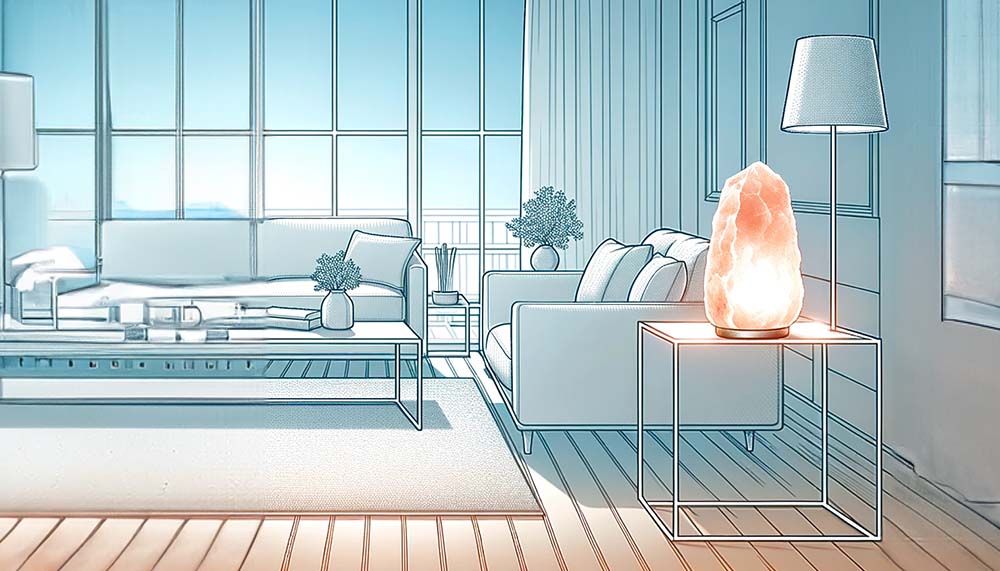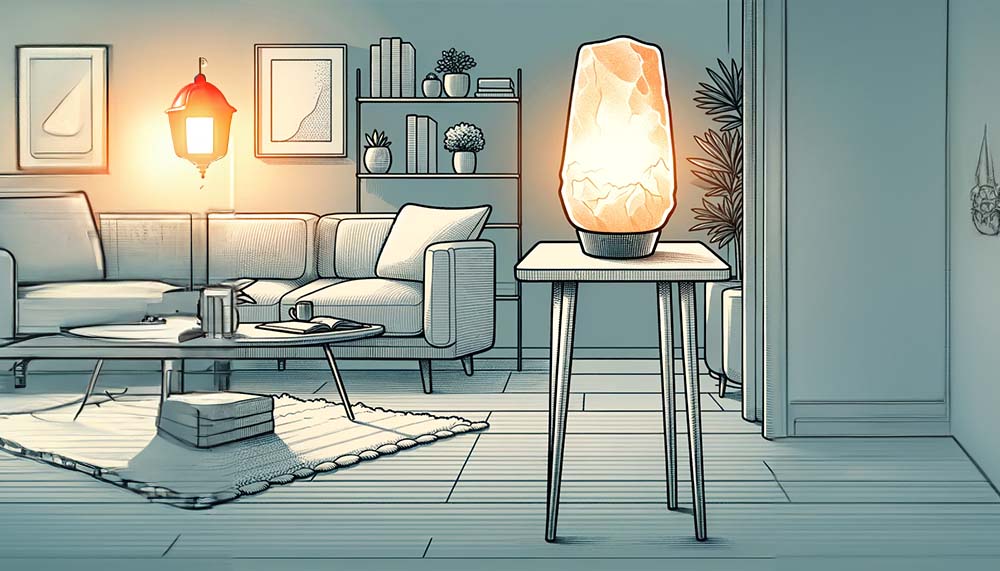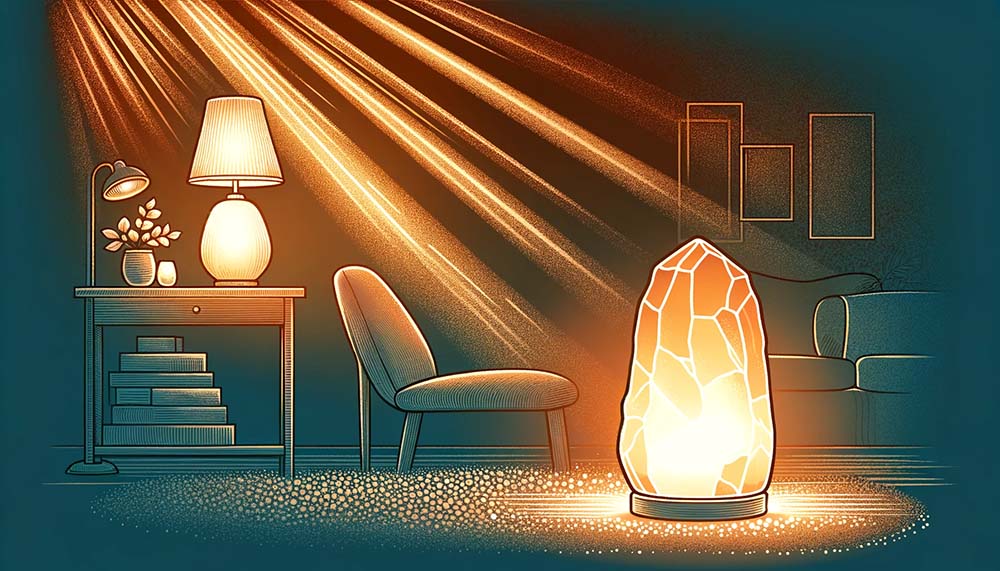Himalayan salt lamps have taken the home decor world by storm in recent years, with many people drawn to their natural beauty and alleged health benefits. These unique lamps, carved from Himalayan salt crystals, are said to purify the air, boost mood, and promote better sleep.
But how exactly do salt lamps work, and are their purported benefits backed by scientific evidence?
Let’s take a closer look at these popular household items.
What Are Himalayan Salt Lamps?

Himalayan salt lamps are decorative lamps made from large, hollowed-out blocks of Himalayan salt crystals. These crystals are mined from the Khewra Salt Mine in Pakistan, located near the foothills of the Himalayas.
The salt from this region is believed to be millions of years old and contains trace amounts of minerals that give it a distinctive pink color.
To create a salt lamp, a block of Himalayan salt is carefully crafted into a desired shape, whether it’s a natural crystal form or a smooth, polished design. A space is carved out in the center of the salt block to accommodate a light bulb or candle.
When illuminated, the lamp emits a soft, warm, pinkish-orange glow that many find soothing and visually appealing.
The Claimed Benefits of Salt Lamps
Proponents of Himalayan salt lamps claim that these devices offer a range of health benefits, primarily related to air purification and mood enhancement. The most common claims include:
- Air Purification: Salt lamps are said to clean the air by attracting and trapping airborne pollutants, such as dust, pollen, and smoke particles.
- Mood Enhancement: Some believe that salt lamps release negative ions, which are thought to have mood-boosting effects and help alleviate symptoms of depression and anxiety.
- Better Sleep: The soft, warm glow of a salt lamp is often touted as a natural sleep aid, promoting relaxation and creating a conducive environment for restful sleep.
- Alleviating Respiratory Issues: Salt lamps are sometimes claimed to help with respiratory problems, such as asthma and allergies, by reducing airborne irritants.
The Science Behind Salt Lamps and Air Purification

The primary mechanism by which salt lamps are claimed to purify the air is through a process called hygroscopy. In simple terms, hygroscopy refers to the ability of a substance to attract and absorb water molecules from the surrounding environment.
Salt, being a hygroscopic substance, naturally attracts water molecules from the air. These water molecules can carry various indoor air pollutants, such as dust, pollen, mold spores, and bacteria.
As the water molecules are drawn to the salt lamp’s surface, the pollutants are believed to stick to the lamp, effectively removing them from the air.
Additionally, some proponents suggest that the heat emitted by the light bulb inside the salt lamp causes the absorbed water to evaporate back into the air, releasing negative ions in the process. Negative ions are believed to have mood-enhancing properties and are often associated with natural environments like waterfalls, beaches, and forests.
Evaluating the Evidence
While the theory behind salt lamps and their air-purifying properties may sound promising, it’s important to examine the available scientific evidence to determine their effectiveness.
Currently, there is limited scientific research specifically focused on the air purification capabilities of salt lamps. A few small studies have suggested that salt lamps may have a minor impact on indoor air quality, but these studies have limitations and their findings are not conclusive.
One study conducted by the Bavarian State Office for Health and Food Safety in Germany found that salt lamps could slightly reduce the concentration of airborne particles in a controlled environment. However, the study also noted that the effect was minimal and that salt lamps should not be considered a replacement for proper ventilation and air filtration methods.
When it comes to the mood-enhancing effects of negative ions, some studies have indeed linked high concentrations of negative ions to improved mood and reduced symptoms of depression. However, it’s important to note that the concentration of negative ions produced by salt lamps is likely much lower than the levels found in natural environments like waterfalls or beaches.
While anecdotal evidence from salt lamp users may suggest positive effects on mood and sleep, more rigorous scientific research is needed to establish a clear link between salt lamps and these benefits.
Additional Benefits and Considerations

Despite the lack of strong scientific evidence supporting the air purification and health benefits of salt lamps, many people still find value in these decorative items for other reasons:
- Ambiance: Salt lamps provide a warm, soothing glow that can create a cozy and inviting atmosphere in any room. The soft light can help promote relaxation and reduce stress.
- Decorative Appeal: The unique appearance of salt lamps, with their natural pink hues and organic shapes, can add a beautiful and natural decorative element to various decor styles.
- Potential Placebo Effect: Even if the scientific evidence is lacking, some people may experience positive effects from salt lamps due to the placebo effect. The belief in the lamp’s benefits may contribute to a more positive mindset and improved well-being.
It’s important to keep in mind that while they are generally safe to use, salt lamps require some care and attention. The hygroscopic nature of salt means that these lamps can be susceptible to moisture damage, especially in humid environments. It’s best to keep salt lamps away from areas with high humidity, such as bathrooms or kitchens, to prevent the salt from dissolving or leaking.
Additionally, salt lamps are fragile due to their crystalline structure, so they should be handled with care to avoid cracks or breakage. Regular dusting and wiping down the surface with a slightly damp cloth can help maintain the lamp’s appearance and prevent the accumulation of debris.
Final Thoughts
Salt lamps have gained popularity in recent years as a natural and visually appealing way to enhance indoor spaces. While the purported health benefits of these lamps, such as air purification and mood enhancement, are not strongly supported by scientific evidence, many people still find value in their soothing ambiance and decorative appeal.
If you’re primarily interested in improving indoor air quality, it’s best to focus on proven methods such as regular cleaning, proper ventilation, and the use of high-quality air purifiers with HEPA filters. These strategies have been shown to be effective in reducing airborne pollutants and promoting a healthier indoor environment.
However, if you enjoy the aesthetic appeal and calming glow of salt lamps, there’s no harm in incorporating them into your home decor. Just remember to handle them with care, keep them away from humid areas, and enjoy their natural beauty without relying on them as a sole solution for air purification or health concerns.
Ultimately, the decision to use a salt lamp comes down to personal preference and the value you place on their decorative and ambient qualities. While more research is needed to fully understand their potential benefits, salt lamps can still be a lovely addition to any space, providing a soothing and visually appealing touch to your home.




